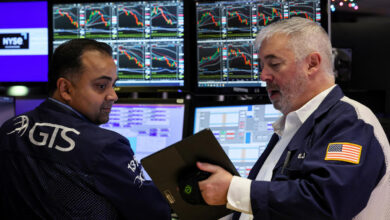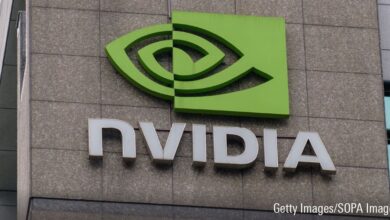The Stock Market Is Melting Up. Prepare for a Short-Term Correction.

No cut, no problem—at least not for the stock market.
It should have been a bad week for an overextended market, one that had risen for 14 of the previous 15 weeks. A pair of stronger-than-expected January inflation prints forced investors to wake up to the realization that the Federal Reserve won’t be cutting interest rates as often or as soon as they’d expected, while a pair of shaky retail sales reports suggested that the economy wasn’t as strong as thought.
None of it amounted to much. The
index lost 0.4% this past week, while setting a record high on Thursday. The
dipped 0.1%, and the
fell 1.3%. Bond yields rose.
There were some harrowing moments. On Tuesday, the S&P 500 fell 1.4% after data showed the consumer price index had increased by 0.3% in January, a tenth of a point more than expected and up 3.1% from a year earlier. The core CPI, which excludes volatile food and energy components, rose 0.4% last month to stretch its 12-month gain to 3.9%—matching the December change and arresting a trend of declining inflation in place for most of the past year. Producer inflation data on Friday similarly topped expectations.
Those inflation readings suggest there’s still too much uncertainty over the direction of prices for the Fed to be loosening monetary policy. Markets are now assigning slim chances of rate reductions at the Fed’s March and May meetings, with June the new consensus start for the Fed’s cutting cycle.
“The January inflation data vindicate the Fed’s wait-and-see approach,” wrote BofA Securities economists on Friday. “Services inflation remains sticky, and the Fed would like to see more progress there to have confidence that inflation is returning to its 2% target on a persistent basis.”
Advertisement – Scroll to Continue
A June start might also prove optimistic, even if January’s inflation jump was just a blip—something that investors will find out over the next four months, Despite last month’s disappointing retail reading, gross domestic product is on track for a 3% annual growth rate in the first quarter, the labor market continues to add jobs, and unemployment is below 4%.
“Investors are beginning to realize that macro conditions don’t warrant rate cuts soon, and if recent job-creation trends continue, there might only be two or three cuts in total this year,” wrote David Bianco, chief investment officer, Americas, at DWS Group.
Investors might even want to consider the possibility that there will be no cuts in 2024, according to Matthew Luzzetti, Deutsche Bank’s chief U.S. economist, offering three conditions for that to happen. First, the Fed’s estimate of the so-called neutral rate needs to be adjusted higher, to about 3.5%. Second, unemployment needs to remain below 4% while other economic data remain solid. Finally, inflation must remain sticky, with core personal-consumption expenditures, the Fed’s favored measure, finishing the year at 2.7% or higher.
Advertisement – Scroll to Continue
The second and third of those conditions merely require January trends to continue, with the first a matter of debate. Three Fed officials already saw a long-term neutral rate—with which monetary policy neither accelerates nor restricts economic growth—of at least 3.5% in the central bank’s latest economic projections in December. More hot inflation and labor-market strength in 2024 could move others to this view, Luzzetti argues. “While this condition for inflation is far from our baseline…recent data suggest the probability of this outcome may not be trivial,” he wrote.
The market, though, might be able to withstand a handful of fewer rate cuts, if for no other reason than a strong economy and robust labor market tend to be good for corporate revenue and earnings. The fact that the S&P 500 made back its post-CPI losses and that the
or VIX, Wall Street’s “fear gauge,” ended the week roughly where it started—at a relatively calm level below 14 points—also suggest that this isn’t a rate-cuts-or-bust market.
“If equities had been driven lower by rising fear, in this case the fear of renewed inflation, then we would not have seen the recovery,” wrote Tim Hayes, chief global investment officer at Ned Davis Research. “Doubts about the timing of something bullish should be distinguished from fears about something bearish, such as resurgent inflation or collapsing economic growth.”
Are investors getting complacent? Perhaps. Last week’s Investors Intelligence sentiment survey showed the highest percentage of self-described bulls since the summer of 2021. Market strategists have been raising year-end price targets for the S&P 500. The Cboe equity put/call ratio is about as low as it gets historically, meaning more bets on rising stock prices than falling. Fund flows have been strong, even with the S&P 500 trading at a demanding 20.5 times 12-month forward earnings.
What’s more, BofA Securities’ February Global Fund Manager Survey included the greatest global growth expectations in two years, falling cash levels, and the highest allocation to U.S. stocks since late 2021. A soft landing is the consensus call—for the first time in nearly two years, a majority of respondents see no global recession in the next 12 months. But, according to respondents to the survey, higher inflation is the most significant tail risk.
The melt-up in stock prices and possibly overextended bullish sentiment suggest that a shallow correction, a decline of 10% or so from recent highs, may be in store in the coming weeks. How earnings are received this coming week—particularly
Advertisement – Scroll to Continue
Nvidia
’s
quarterly results on Wednesday—will have a big impact on sentiment and could easily be the catalyst for a correction.
But just a correction. The lack of impending interest-rate cuts may not justify the S&P 500’s valuation, but above-average earnings-growth prospects might. S&P 500 earnings per share are forecast to rise more than 9% this year, then another 13% in 2025, per analyst consensus figures from Refinitiv.
Advertisement – Scroll to Continue
“Risk appetite and valuations rise when an improving, solid economic outlook enhances investors’ confidence that corporations will be able to deliver consistent profit growth,” wrote Evan Brown, head of multi-asset strategy at UBS Wealth Management. “That is the environment we find ourselves in today.”
It’s an environment that should have stocks moving up and to the right.
Write to Nicholas Jasinski at nicholas.jasinski@barrons.com





